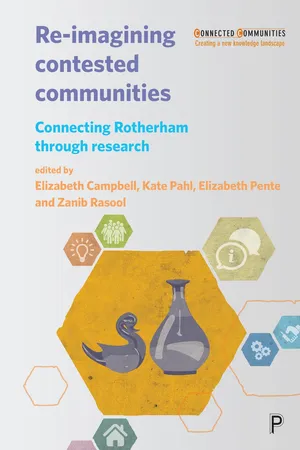
- 192 pages
- English
- PDF
- Available on iOS & Android
About this book
This is a book that challenges contemporary images of 'place'. Too often we are told about 'deprived neighbourhoods' but rarely do the people who live in those communities get to shape the agenda and describe, from their perspective, what is important to them. In this unique book the process of re-imagining comes to the fore in a fresh and contemporary look at one UK town, Rotherham. Using history, artistic practice, writing, poetry, autobiography and collaborative ethnography, this book literally and figuratively re-imagines a place. It is a manifesto for alternative visions of community, located in histories and cultural reference points that often remain unheard within the mainstream media. As such, the book presents a 'how to' for researchers interested in community collaborative research and accessing alternative ways of knowing and voices in marginalised communities.
Frequently asked questions
- Essential is ideal for learners and professionals who enjoy exploring a wide range of subjects. Access the Essential Library with 800,000+ trusted titles and best-sellers across business, personal growth, and the humanities. Includes unlimited reading time and Standard Read Aloud voice.
- Complete: Perfect for advanced learners and researchers needing full, unrestricted access. Unlock 1.4M+ books across hundreds of subjects, including academic and specialized titles. The Complete Plan also includes advanced features like Premium Read Aloud and Research Assistant.
Please note we cannot support devices running on iOS 13 and Android 7 or earlier. Learn more about using the app.
Information
Table of contents
- RE-IMAGINING CONTESTED COMMUNITIES
- Contents
- List of figures
- Notes on contributors
- Acknowledgements
- Series editors’ foreword
- Part One. Introductions
- 1. What kind of book is this?
- 2. Policy, practice and racism: social cohesion in action
- Part Two . Community histories
- 3. Introducing Rotherham
- 4. How can historical knowledge help us to make sense of communities like Rotherham?
- 5. Some poems, a song and a prose piece
- 6. Who are we now? Local history, industrial decline and ethnic diversity
- 7. Silk and steel
- 8. History and co-production in the home: documents, artefacts and migrant identities in Rotherham
- 9. Tassibee: a case study
- 10. Identity
- Part Three. Community ways of knowing
- 11. Methodology: an introduction
- 12. Collaborative ethnography in context
- 13. Safe spaces and community activism
- 14. Emotions in community research
- 15. What parents know: a call for realistic accounts of parenting young children
- 16. Where I come from and where I’m going to: exploring identity, hopes and futures with Roma girls in Rotherham
- 17. Introduction to artistic methods for understanding contested communities
- 18. What can art do? Artistic approaches to community experiences
- 19. Using poetry to engage the voices of women and girls in research
- 20. The Tassibee ‘Skin and Spirit’ project
- 21. ‘The Rotherham project’: young men represent themselves and their town
- Part Four . Communities going forward
- 22. Re-imagining contested communities: implications for policy research
- 23. What this book can teach us
- References
- Index